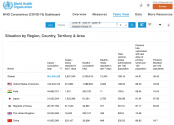With reporting of up to 900 million Chinese already infected, I'll find that getting below 1 million deaths to be a miraculous success to be honest.
No amount of health care infrastructure will cope with that amount of sick people in such a short period of time. We'll need to wait and see official excess death statistics before making bold predictions about how many people passed from this wave unfortunately.
Even if fully vaxxed would confer 99% effectiveness against severe illness, you will still get 9 million severely ill people if we extrapolate from the 900 million figure.
The actual number is far lower than your forecast, and the number of severe cases peaked at 128,000 on January 5! In addition, the highest number of hospitalizations is 1.625 million! Chinese hospitals can fully bear it, please don't make random guesses and create anxiety!
----
Jiao Yahui, director of the Department of Medical Affairs of the National Health and Medical Commission, replied: According to our monitoring data, the number of hospitalized COVID-19 patients is showing a continuous downward trend. It reached a peak of 1.625 million hospitalized COVID-19 infections on January 5, and then continued to decline, falling back to 1.27 million on January 12. Among them, 1.17 million people were admitted to medical institutions above the second level, and 100,000 people were admitted to designated hospitals and sub-designated hospitals. The proportion of patients infected with the new crown showed a continuous downward trend. It reached a peak of 27.5% on January 3, then continued to decline, and fell back to 21.7% on January 12, a drop of 5.8 percentage points from the peak period.
According to monitoring data, 2 weeks after the peak of fever outpatient visits, the number of severe patients with new crown positive in the hospital also reached its peak, and then showed a slow downward trend. The number of critically ill patients currently in hospital is still at a high level. On January 5, 2023, the number of COVID-19-positive critically ill patients in the hospital peaked at 128,000, and then continued to fluctuate and decline. By January 12, the number of positive critically ill patients in the hospital fell back to 105,000, and the utilization rate of intensive care beds was 75.3%. , the intensive care beds can meet the needs of treatment. Among the critically ill COVID-19 patients in the hospital on January 12, there were 97,000 patients with severe underlying diseases combined with COVID-19 infection, accounting for 92.8%. There are 7,357 critically ill patients infected with the new coronavirus, accounting for 7%. From the perspective of data analysis, severe patients infected with the new coronavirus have the following characteristics: First, they are mainly elderly. The oldest is 105 years old, and the average age is 75.5 years old. The proportion of those aged 60 and over is 89.6%. Second, it is common to have multiple underlying diseases. Patients with one basic disease accounted for 40.7%, two basic diseases accounted for 24.6%, and three or more basic diseases accounted for 34.8%. Most basic diseases are cardiovascular and cerebrovascular diseases, endocrine system diseases and respiratory system diseases.

